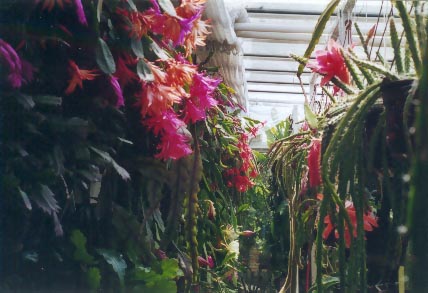

EPIPHYTIC CACTI CULTURE
A PATH OF MY GREENHOUSE
THE PLACE OF MY COLLECTION
I've been collecting cacti in the Paris area since 1988 in a veranda used as a cold greenhouse. In my collection, I noted that epiphytic cacti adapt better than many of the globular ones to our climate which is not always very sunny . However, it is necessary to provide sufficient sunlight to these epiphytes, for their vegetative growth and particularly too, for their flowering.
Thus, I cultivate in a cold greenhouse facing South, where the temperature is always maintained above approximately 8°C, using electric convectors. I maintain a minimal temperature of approximately 15°C before the period of Schlumbergera flowering whose color is sensitive to the minimal temperature. (This especially for the hybrids with white or yellow flowering which have flowers with strongly pink colour when this requirement is not respected).
During the summer (approximately from mid-June to the end of September), I carry all my collection in my garden, in a place where the sun is filtered by trees. This outside stay is much appreciated by my plants ; looking at their vegetative appearance proves it.
SOIL
As many collectors, I do not cultivate epiphytic cacti like epiphytes
i.e. growing on pieces of tree trunks for example. I grow them like terrestrial
ones, rooted in pots filled with compost. These pots are generally hanging pots.
Soil must always have an acid pH. I use a mixture of heath-mould and lava waste
which drains and aerates the soil. This mixture also contributes to keep the
soil lightly moist. I currently try to use perlite or vermiculite instead of
lava. These materials are lighter in weight.
WATERINGS
Epiphytic cacti do not like a dry compost during long periods
(except possibly in winter). To maintain the acidity of the ground pH as much
as possible, I exclusively water with rainwater gathered from my house's roof.
Frequency of waterings varies from once in every three weeks in winter to once
a week, from the beginning of spring, when the plants are still in the greenhouse.
For the summer outside stay, I rely on the rainy climate of the Paris area and
I rest.
FERTILIZERS
I think that if we use them carefully, fertilzers appear extremely
useful for both the vegetative growth and the flowering. When repotting, it's
possible to incorporate special 9-13-18 cacti osmocote to the compost. I also
regularly mix liquid geranium fertilizer with the water, once in every two or
three waterings, particularly for the formation and the development of the flowers.
A well-known brand of fertilizer sells a special cartridge connected between
the watering hose and the spray gun. This cartridge, filled with fertilizer
powder, dissolves itself in the water with suitable concentration. I use this
very easy method.
PESTS AND PARASITES
It is often said that correctly cultivated plants are less sensitive
to parasites and diseases; this is true, however, it is necessary to be ready
to act if necessary, and even to act preventively. The most frequent parasites
in my collection are mealy bugs and root mealy bugs, red spider mites, but also
snails and slugs as well as caterpillars. Against the mealy bugs and root
mealy bugs, I treat all my collection once a year in my garden with a systemic
product. This treatment has both a curative and preventive effect. Using this
method I don't have major problems. Against the red spider mites, more difficult
to detect in time, I apply a dicofol spraying to all the plants, as soon as
I notice the presence of these parasites ; it is often in spring, when the temperature
start to rise and then, the reproduction of these acarids tends to speed up.
Paradoxically, the caterpillars attack mostly in autumn and winter; one
or two sprayings containing bacillus thurigensis ( biological agriculture product,
common in garden centers) allow to eliminate these parasites which can quickly
cause heavy damages. I will not elaborate too long on snails and slugs
which attack mostly in summer, in my garden; they should not be neglected but
simple anti-slugs granules are sufficient.
DISEASES
Except for some botanical species and some hybrids (often hybrids of Californian origin) which frequently necrose in winter, my epiphytic cacti are not very sensitive to diseases.
I notice only some cases of rot of stems and I only cut these
stems to avoid a possible extension of the disease. Some botanical Epiphyllums
tend to necrose in winter and to have a weak growth, I did not find any solution
to this problem. Some hybrids appear to suffer from viral attacks. I haven’t
found any solution to this problem either, but these plants do not appear to
contaminate other ones. Except for these cases, most of my Epiphytes grow healthy.